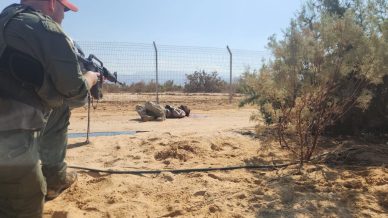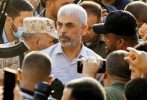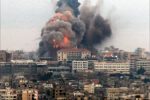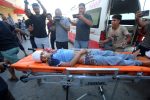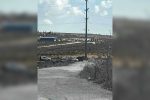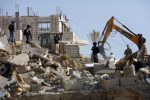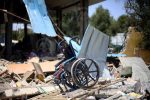GAZA, (PIC)
More than a year after the Al-Aqsa Flood battle and the subsequent collective Israeli extermination, leader Yahya Sinwar, head of Hamas, rose as a martyr, facing the enemy head-on with his weapon drawn, engaging with the occupying army at the forefront of the most dangerous combat zones in Rafah, southern Gaza.
Despite possessing the most advanced surveillance and tracking devices, the occupation forces failed for an entire year to locate Sinwar, whom their propaganda claimed was hiding in tunnels or among civilians. The surprise came with his martyrdom in an armed confrontation with an Israeli force at the front lines in Rafah, as acknowledged by the occupation army spokesperson, Daniel Hagari.
Hagari said, “We did not know he was there. Initially, we identified him as an armed man inside one of the buildings, and he was seen masked, throwing a wooden plank at the drone just seconds before his martyrdom.”
The engaging leader
The leaked image of the architect of the Al-Aqsa Flood, Hamas leader Yahya Sinwar, showed him in his final moments, wearing a military pouch and fighting the invading occupiers until his last breath. He even tied his bleeding hand with iron wire in hopes of stopping the bleeding with a severed foot, refusing to retreat, appease, or hide, contrary to what Israel and its supporters had propagated.
Israel’s black propaganda apparatus has long claimed that the number one target was hiding among civilians or underground, yet it admits he fought until the final seconds, attempting to down a drone with a piece of wood available to him in that historic moment, perhaps to reveal the shame that weighs on a silent, complacent, or complicit world.
Moving between combat sites
Hamas confirmed in its statement that leader Sinwar was moving between all combat sites, steadfast and resolute on the blessed land of Gaza, defending Palestine and its sacred sites, inspiring the spirit of steadfastness, patience, and resistance.
The martyrdom of the leader was expected, yet the manner of his martyrdom in combat came as a surprise to many. However, he chose it with his will and determination, and Allah honored him with it, having carried the burden of his cause from an early age.
Leader martyr Yahya Sinwar lived as a fighter, carving his path in Hamas since he was a young man involved in its jihadist activities, establishing the security apparatus known as “Majd,” and participating in activities within the Islamic Bloc at the Islamic University.
He spent 23 years in captivity, defying the Israeli jailers, and after his release from prison in the Wafa al-Ahrar deal, he continued his contributions, planning, and jihad, holding several leadership positions in Hamas until he became its head following the assassination of martyr Ismail Haneyya.
Engineering the Flood
Leader Yahya Sinwar survived several assassination attempts, including one on April 11, 2003, when an explosive device was planted in the wall of his home in Khan Yunis, southern Gaza, and another in May 2021 during the fourth Israeli war on Gaza. His eyes opened to the events of October 7, 2023, the day of the great flood that shook the core of the “entity and exposed the fragility of its supposed security, followed by the legendary steadfastness of our people and the valor of our victorious resistance.” He achieved the highest honor and ascended to be with his Lord, content with the struggle and sacrifice he made.
His contributions to the Al-Aqsa Flood operation, and his description as the architect of the operation that shook the “Zionist entity”, were among the most significant milestones in the honored life of the man who fully understood that leadership positions in Hamas are a duty, not an honor. The leaders of the Movement have ascended as martyrs throughout the long struggle, starting with the founder Sheikh Ahmed Yassin and ending with Sinwar.
His martyrdom was not merely a coincidence or an expectation, but a wish and hope expressed by Abu Ibrahim in a public meeting three years ago. He said, “The greatest gift the enemy and the occupation could give me is to assassinate me and for me to die a martyr at their hands. I am 59 years old today. I would actually prefer to be martyred by an F16 than to die from COVID-19, a stroke, a traffic accident, or in any other way that people die.”
The man continued to explain this wish, saying, “At this age, I would prefer to die a martyr than to die a natural death.”
Thus, Sinwar was martyred as he wished; he was martyred while wearing his military uniform and fighting with all his strength, and he was not hiding in a tunnel, as Israeli Prime Minister Benjamin Netanyahu repeatedly claimed.
The image of victory
Just as Al-Sanwar deprived the occupation of security during the Al-Aqsa Flood, he also denied them a victory image in his final moments—an image they had long dreamed of. Despite all the military and intelligence capabilities, and the support from major international powers amid regional silence, this massive army could only kill its resistant enemy by chance during a routine sweep the day after the clashes.
The Israeli army published what it claimed were the last moments of the head of the political bureau of Hamas, Yahya Al-Sinwar, after he was martyred while fighting with occupation forces in the city of Rafah in southern Gaza last Wednesday.
According to the Israeli narrative, the occupation forces initiated the engagement with three individuals without being able to identify them. One of them—later identified as Al-Sinwar—sought refuge alone in one of the buildings before an Israeli drone scanned the area.
The photos released by the Israeli army show Al-Sinwar, masked, sitting on a chair and throwing a wooden plank at an Israeli drone that entered the building, before he was targeted by a tank shell.
Analyzing the photos
Military expert Brigadier General Elias Hanna believes that the Israeli photos indicate that Al-Sanwar was injured and attempted to fend off an Israeli drone with a wooden stick. He stated that these images undermine the Israeli narrative that Al-Sinwar was sheltering among detained prisoners and that his assassination was purely coincidental, indicating a tactical and intelligence blindness.
According to political researcher Said Ziad, Al-Sinwar was aware he was going to die since he launched the Al-Aqsa Flood operation on October 7, 2023, but he died as a fighter and not in hiding. Ziad also believes that Al-Sinwar’s death grants him a heroism he deserves, as he died with his weapon in hand and was not hiding like a rat or surrounded by civilian prisoners, as Israeli leaders have claimed all along. Moreover, he was martyred by chance and not due to a complex intelligence or military operation.
A death that undermines the Israeli narrative
Israeli affairs expert Ihab Jabareen concurred with Ziad, explaining that Al-Sinwar’s death was marked by coincidences that deprived Israel of a narrative that would present his death as a victory, as they had in previous planned assassination operations. Given these circumstances, the martyrdom of Al-Sanwar occurred naturally and did not allow the Israeli narrative any opportunity to intervene.
Jabareen noted that Al-Sinwar was a target for which Israel justified numerous operations under the pretext of searching for him, meaning that the current developments push Israel to sit at the negotiating table after the killing of its number one target.
Ziad pointed out that Hamas would be affected by Al-Sinwar’s departure, as would the Gaza Strip, but neither would collapse afterward, just as they did not fall when Abdul Aziz Rantisi, almost the only successor to the Movement’s founder Sheikh Ahmad Yassin, was martyred.
He added that reaching a man of Al-Sinwar’s stature by chance leaves Israeli Prime Minister Benjamin Netanyahu unable to present a victory narrative, as he is known as the king of narratives.
Currently, as Jabareen and Ziad suggest, Netanyahu will face questions about his seriousness in recovering the Israeli captives and stopping a war for which he has long held Al-Sinwar responsible for the failure of any agreement to stop it.
Beyond all these details, Israel faces the dilemma of the lie surrounding Al-Sinwar’s hiding and the difficulty of reaching him after he was martyred in a regular confrontation inside a house on the ground, as Jabareen said.



